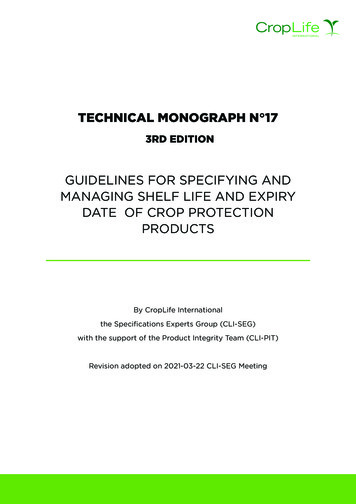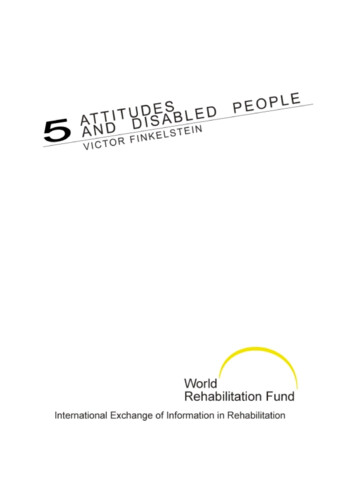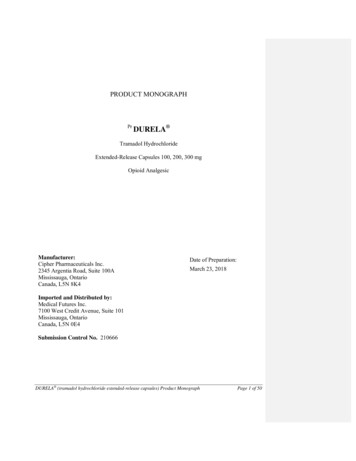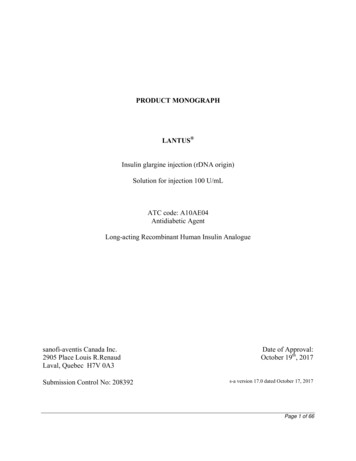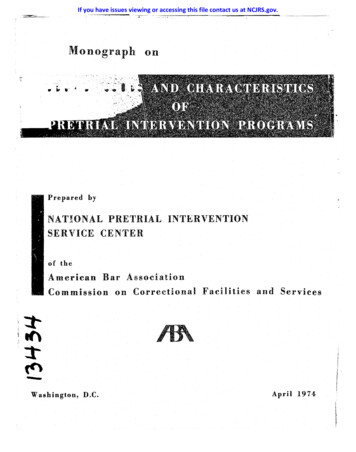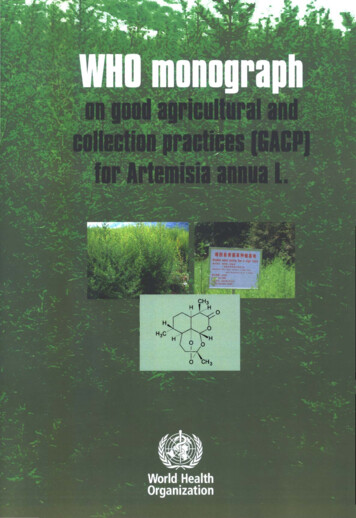
Transcription
WHO monograph ongood agricultural and collection practices(GACP)for Artemisia annua L.
WHO Library Cataloguing‐in‐Publication DataWHO monograph on good agricultural and collection practices (GACP) for Artemisia annua L.1.Artemisia annua ‐ growth and development. 2.Agriculture ‐ standards. 3.Antimalarials. 4.Qualitycontrol. I.World Health Organization.ISBN 92 4 159443 8ISBN 978 92 4 159443 1(LC/NLM classification: SB 295.A52) World Health Organization 2006All rights reserved. Publications of the World Health Organization can be obtained from WHOPress, World Health Organization, 20 Avenue Appia, 1211 Geneva 27, Switzerland (tel.: 41 22 7913264; fax: 41 22 791 4857; e‐mail: bookorders@who.int). Requests for permission to reproduce ortranslate WHO publications – whether for sale or for noncommercial distribution – should beaddressed to WHO Press, at the above address (fax: 41 22 791 4806; e‐mail: permissions@who.int).The designations employed and the presentation of the material in this publication do not implythe expression of any opinion whatsoever on the part of the World Health Organization concerningthe legal status of any country, territory, city or area or of its authorities, or concerning thedelimitation of its frontiers or boundaries. Dotted lines on maps represent approximate border linesfor which there may not yet be full agreement.The mention of specific companies or of certain manufacturers’ products does not imply that theyare endorsed or recommended by the World Health Organization in preference to others of asimilar nature that are not mentioned. Errors and omissions excepted, the names of proprietaryproducts are distinguished by initial capital letters.All reasonable precautions have been taken by the World Health Organization to verify theinformation contained in this publication. However, the published material is being distributedwithout warranty of any kind, either expressed or implied. The responsibility for the interpretationand use of the material lies with the reader. In no event shall the World Health Organization beliable for damages arising from its use.Printed in Switzerland
AcknowledgementsThe World Health Organization (WHO) expresses its appreciation of thegenerous support provided by the Government of the People's Republic of Chinafor the development, convening of a WHO Consultation, and publication of themonograph both in English and Chinese.WHO also acknowledges its indebtedness to the more than 100 reviewers,including experts and national authorities, in over 36 countries who providedcomments and advice on the draft text. Preparation of the monograph benefited,in addition, from technical support received from relevant United Nationsagencies and programmes, especially the Food and Agriculture Organization ofthe United Nations, the United Nations Children’s Fund, internationalorganizations and nongovernmental organizations.Special thanks are due to participants at the WHO Consultation on goodagricultural and collection practices on Artemisia annua L, held in Nan Ning,Guanxi, China in July 2005 to review the draft guidelines (see Annex 1).Grateful thanks for the preparation of the original text are also due to ProfessorZhang Bengang, Institute of Medicinal Plant Development, Chinese Academy ofMedical Sciences, a WHO Collaborating Centre for Traditional Medicine, inBeijing, China. WHO also thanks those who provided technical information toWHO prior to the drafting the monograph.Finally, WHO wishes to thank the State Food and Drug Administration of China,who kindly hosted, with the support of the Guangxi Food and DrugAdministration, the WHO Consultation in July 2005.i
ii
PrefacePrefaceTraditional medicine, a valuable treasure of the Chinese nation, is an importantcomponent of the medical science in China. In the thousands of years of Chinesehistory, traditional medicine has played a significant role and made an indeliblecontribution to the health of the Chinese people. During the last two decades,traditional Chinese medicine has been increasingly accepted by many othercountries. A good example is acupuncture, which is being used for clinicaltreatment in most of the countries in the world.Since the founding of the People’s Republic of China, the Government of Chinahas made unswerving efforts to promote the development of traditional Chinesemedicine, which has become an important component of the contemporarymedical medicine. The extraction of artemisinin from traditional herbs as a veryefficacious antimalaria drug, is an example of the successful combination oftraditional Chinese medicine and modern medicine.Today in the 21st century, malaria, the ancient disease, is still severelychallenging people’s health. Each year, more than one million people around theglobe die of malaria and more than two billion people in over 100 countries andregions are threatened by the disease. In many developing countries, especiallythose in Africa, the morbidity and mortality from malaria are still very high.Malaria has had serious impact on the social and economic development ofmankind. In order to effectively curb the spread of malaria in the world, WHOhas recommended the use of artemisinin-based combination therapies (ACT) forthe treatment of this disease.In September 2005, the Chinese President Mr Hu Jintao pronounced at the 2005World Summit that China will strengthen its cooperation with developingnations in terms of prevention and control of HIV/AIDS, malaria and otherinfectious diseases, and increase relevant assistance to developing countries,especially African countries.China is the place of origin of Artemisia annua L., the largest supplier country ofArtemisia annua L raw material on the global market, and the first country toextract artemisinin. And artemisinin is a significant contribution of traditionalChinese medicine to the world. China not only has a wealth of experience in theproduction and usage of artemisinin, but also has unique skills in the cultivationof Artemisia annua L. We stand ready to strengthen exchange and cooperationwith WHO and relevant countries in treating malaria using artemisinin, and tomake a vigorous contribution to curbing the spread of malaria in the world.iii
WHO monograph on good agricultural and collection practices (GACP) for Artemisia annua L.China actively supported WHO in developing this monograph on the cultivationof Artemisia annua L. It is hoped that the publication of this monograph will behelpful for the prevention and treatment of malaria around the globe. We arewilling to continue working together with other countries and WHO inpromoting traditional Chinese medicine to serve the health of the people aroundthe world.Mr Gao QiangMinister of HealthPeople's Republic of Chinaiv
ContentsContentsAcknowledgements . iPreface . iiiContents . v1. Introduction . 11.1 Background . 11.2 Objectives . 22. Botanical and pharmacological characteristics of Artemisia annua L. 52.1 Name of plant . 52.2 Medicinal plant part of interest. 52.3 Geographical distribution and the major areas of cultivation. 62.4 Morphological characteristics of live A. annua . 62.5 General description of characteristics of plant material. 62.6 Chemical composition . 72.7 Pharmacological activity . 82.8 Clinical applications . 103. Good agricultural practices . 113.1 Growth and development characteristics. 113.2 Preferred growing conditions . 123.3 Seeds . 133.4 Cultivation method. 143.5 Prevention and control of plant diseases and pests . 153.6 Harvest and postharvest processing . 153.7 Personnel . 164. Good collection practices. 174.1. The principles for collecting wild A. annua . 174.2 Permit for collecting. 174.3 Botanical identification of wild A. annua . 174.4 Requirements for collection. 184.5 Training of personnel prior to collection of plants. 184.6 Collecting time. 184.7 Quality evaluation prior to collection . 184.8 Others. 195. Quality control requirements for herbal materials of A. annua. 215.1 Basic quality requirements for herbal materials . 215.2 Basic quality specification for herbal materials of A. annua. 225.3 Methods for quality analysis . 22v
WHO monograph on good agricultural and collection practices (GACP) for Artemisia annua L.6. Other common management and technical requirements for both cultivatedand collected A. annua . 256.1 Bulk packaging . 256.2 Labelling. 256.3 Transportation . 256.4 Storage . 266.5 Quality assurance. 266.6 Document management . 266.7 Personnel . 27References. 29Annex 1. List of participants in the WHO Consultation on Good Agriculturaland Collection Practices for Artemisia annua L. . 33Annex 2. Quality specification for artemisinin and its chemical derivatives . 37Annex 3. Personnel . 47vi
Introduction1. Introduction1.1 BackgroundArtemisia annua L. is a traditional Chinese medicine. It has been used in China formore than 2000 years for treating many disorders including malaria. Theisolation of artemisinin from Artemisia annua L. and the characterization of itsantimalarial effect in the 1970s was initiated by Chinese scientists. This was oneof the most important advances in malaria control in modern times.The WHO Roll Back Malaria department has reported that recent estimates of theglobal malaria burden have shown increasing levels of malaria morbidity andmortality, reflecting the deterioration of the malaria situation in Africa during the1990s. About 90% of all deaths from malaria occur in Africa, in the areas south ofthe Sahara, and the great majority of these are in children under the age of fiveyears.Key among the factors contributing to the increasing malaria mortality andmorbidity is the widespread resistance of Plasmodium falciparum to conventionalantimalarial drugs, such as chloroquine, sulfadoxine–pyrimethamine (SP) andamodiaquine. Multidrug-resistant P. falciparum malaria is widely prevalent insouth-east Asia and South America.In response to increasing levels of antimalarial resistance, since 2001 WHO hasrecommended
(GACP) for other medicinal plants; protect the wild resources of medicinal plants, in particular Artemisia annua L., to ensure their sustainable use. 1.2.1 Utilization The monograph provides a detailed description of the techniques and measures required for the cultivation and collection of Artemisia annua L. This information
